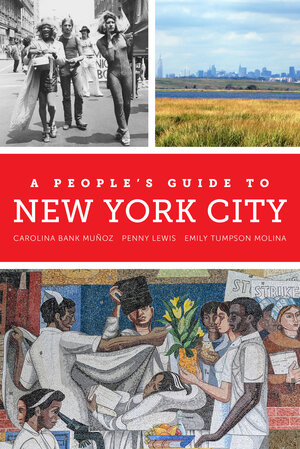Welcome to the virtual tour of A People’s Guide to New York City! Unlike traditional guidebooks that highlight the glitz, glamor, consumption, and spectacle of cities, often at the expense of people of color, immigrants, the working class, and LGBTQ communities, A People’s Guide to NYC offers an alternative perspective on the city— one that treats the life and landscape of the New York as the products of social power and its attendant struggles.
Black history plays a prominent role in our book. From Sandy Ground, the oldest community established by free Black people in North America, to the Birthplace of Hip Hop in the Bronx, we celebrate the struggles, movements, and people who have confronted and continue to confront systemic racism.
We are thrilled you can join us.
—Carolina Bank Muñoz, Penny Lewis, and Emily Molina, co-authors of A People’s Guide to New York City
Learn more about A People’s Guide Series.
Bronx — Birthplace of Hip Hop
1520 Sedgwick Avenue, Bronx, NY
On August 11, 1973, Cindy Campbell threw a party in the rec room of this apartment building. Her brother Clive (better known as DJ Kool Herc) hooked up the PA system he had been experimenting with to spin dancehall, soul, and funk for their one hundred guests, and what would come to be hip-hop culture was born.
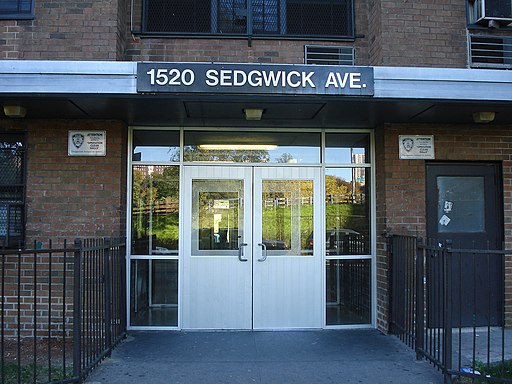
DJ Kool Herc was born and grew up in Kingston, Jamaica, where he snuck out to watch the comings and goings at the local dances, too young to go in. He came to the Bronx at the age of twelve in 1967. Once the family settled in the Bronx, Herc’s father was an avid record collector, and his mother Nettie took him to house parties. When his father bought a PA system to serve as a soundman for a local R&B group, Herc tinkered with it until he made it operate at its peak. After throwing their first party with the newly optimized equipment, Cindy and Herc continued to throw monthly parties in the rec room with Herc spinning records, interspersing little rhymes and shout-outs in his echoing mic, Jamaican yard dance style.
Eventually Herc moved the parties to nearby Cedar Park, where he, like the other DJs popping up all over the South Bronx, hooked his equipment up to the lampposts for power. Journalist Jeff Chang writes, “The moment when the dancers really got wild was in a song’s short instrumental break, when the band would drop out and the rhythm section would get elemental. Forget melody, chorus, songs—it was all about the groove, building it, keeping it going. Like a string theorist, Herc zeroed in on the fundamental vibrating loop at the heart of the record, the break.” People came out to the park to hear Herc hone his Merry-Go Round technique, where by playing two copies of the same record he could keep the break going.
While Herc continued to spin in the West Bronx parks, Afrika Bambaataa was founding the Universal Zulu Nation, the “first hip-hop institution,” out of the Bronx River Houses; Grandmaster Flash was deejaying with the Furious Five; and Grand Wizzard Theodore was inventing scratching not far from Charlotte Street. Bronx youth, starved for the opportunity to learn to play instruments in their schools, listened to the radio and their parents’ records and invented a musical style using what they had—PA systems, microphones, records, and their speaking voices. Along with their fellow artists scribbling graffiti on the subway and dancing in the cypher, they birthed what continues to be one of the most significant cultural movements in the world.
Manhattan — Mabel Hampton’s Former Apt
120 W. 122nd Street, New York NY (demolished)
In the early-twentieth century, Harlem and Greenwich Village emerged as the two primary New York districts filled with gathering spaces for queer people, a group becoming more visible than ever before. Harlem emerged as the epicenter of Black queer culture, epitomized not only by the more well-known literary figures of the Harlem Renaissance but also “everyday” people who helped connect the community and lived boldly long before the modern gay rights movement. Mabel Hampton is such an “everyday” figure, whose apartment here during the 1920s and ’30s was home to parties hosted by Hampton and her neighbors for their female friends who also loved women—commonly known as “lady lovers” at the time.
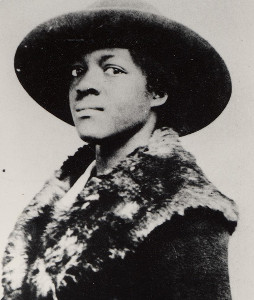
In 1923, at the age of twenty, North Carolina–native Hampton moved into an apartment at this address after a friend who lived next door recommended it to her. Hampton was performing as a chorus girl at the Lafayette Theatre and the Garden of Joy in Harlem at the time, and many well-known performers attended the parties that she and her neighbors began to throw regularly. Hampton rubbed shoulders with many stars of her day, such as Broadway singer and actor Ethel Waters, blues recording artist Alberta Hunter, and Gladys Bentley, whose piano skills, sharp tuxedo, and dirty ditties kept crowds up all night in Harlem speakeasies during the Prohibition era. Sometimes Hampton and her friends would hold “pay parties” in her neighbors’ basement apartment where they would serve food, such as chicken and potato salad, and guests would pay to take part. This was somewhat akin to the “rent parties” Hampton and others attended in Harlem during Prohibition and the Great Depression, where apartment dwellers sought to ease the burden of their high rents through charging guests money for drinks, which would go toward their monthly rent bill. At these parties, many women arrived in skirts, worn for safety on the street, but took them off to reveal pants, which were still rarely worn in public by women. During a time in which Harlem was “in vogue” with white “slumming” elites who sought to loosen their regimented lives and embrace the “primitive” and “exotic” amid the local Black community, house parties like Mabel Hampton’s served as significant spaces for Black women who did not want to be objects of the white gaze. This site memorializes the important role women like Hampton played in creating and sustaining emerging Black queer networks in the early twentieth century that today serve as a legacy to the rich culture and community of “Gay Harlem.”
—Cookie Woolner
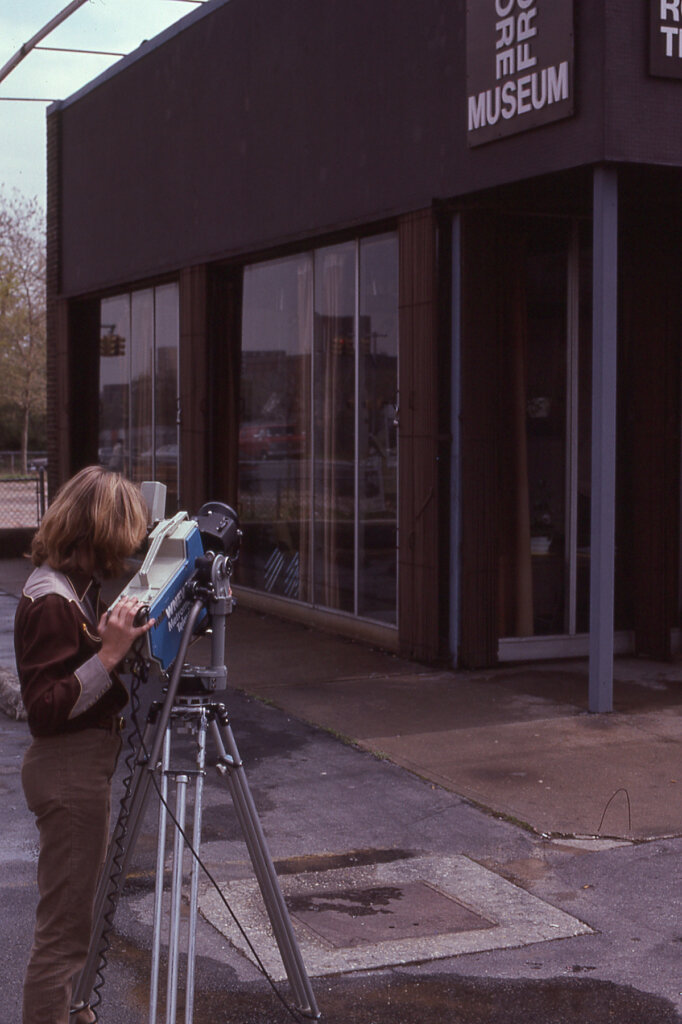
Queens — Storefront Museum
162–02 Liberty Avenue, Jamaica, NY
In 1971, the Store Front Museum opened its doors in Jamaica, Queens, with the intention of becoming an accessible center of culture rooted in Afrocentric philosophy. Established on a site designated for the eventual expansion of York College, the twelve-thousand-square-foot building was rented at a cost of five dollars a month. The museum hosted several major exhibitions and amassed a collection of art, books, photographs, and artifacts. It quickly expanded, opening the Paul Robeson Theatre and hosting Africa Festival, a two-day event on its outdoor mall that attracted thousands of visitors. The institution also organized workshops on Black ancestry and events for local businesses and professional organizations. The museum stood at this site for fifteen years before it was evicted by the City of New York.
The founding and short-lived success of the Store Front Museum was due in large part to founder Tom Lloyd, a Queens-born artist and social activist. From the late 1960s through the 1970s, Lloyd was part of the Art Workers’ Coalition (AWC) where he worked alongside contemporary artists such as Faith Ringgold, Jacob Lawrence, and Raphael Montañez Ortiz (who founded El Museo del Barrio in East Harlem). The group’s activism was aimed at making museums more democratic, and they staged several acts of protest at the Museum of Modern Art and the Metropolitan Museum of Art. In early 1969 the AWC made “13 Demands” of the MoMA, which included free admission, an area of the Museum dedicated to Black artists and under their direction, and, the third demand that “the Museum’s activities should be extended into the Black, Spanish and other communities. It should also encourage exhibits with which these groups
can identify.”
When the Store Front Museum closed after several attempts to relocate to a permanent home, Lloyd donated the entirety of the museum collection to the Queens Library in Jamaica, within walking distance of the museum’s former site.
—Brandon Martinez
Brooklyn — Ebinger Bakery Boycott
2207 Albemarle Road, Brooklyn, NY

This is the former site of one of the major truck depots of the Ebinger Baking Company, which opened its first store in Flatbush in 1898. It is also the site of a 1962 civil disobedience in protest of Ebinger’s discriminatory hiring practices. Ebinger was once a household name in New York City, famous for its German pastries and later for its Brooklyn Blackout cake, which has been adapted by scores of Brooklyn bakeries since. By the time of its closing in 1972 it was the largest retail bakery on the East Coast, with sixty-seven stores across Brooklyn, Queens, Staten Island, and Long Island. But Ebinger’s had a troubled history. In the 1930s, the bakery was accused of Nazi affiliation and of discrimination against Jews. By the 1950s most of its clientele was Jewish, though the bakery staff did not reflect this; as Brooklyn’s demographics shifted after World War II, the bakery’s clientele increasingly became Black and Puerto Rican, yet they were rarely hired. Some Black Americans worked as janitors or as low-level employees in the bakery division, but no Black or Puerto Rican women were hired as “Ebinger Girls” in the retail stores, or as high-level bakery staff or managers. As a result, the Congress of Racial Equality (CORE), along with Operation Unemployment, targeted the Ebinger Baking Company for their jobs campaign to combat urban employment discrimination. Their goal was to push Ebinger’s to hire more people of color in its retail stores, bakery, and truck depots.
This campaign established the Brooklyn Chapter of CORE as one of the one of the most radical in the country, even inspiring students at nearby Erasmus High School to form their own chapter. The campaign was defined by repeated betrayals on the part of Ebinger’s, and escalating tactics on the part of CORE. After an initial approach and negotiation, Ebinger agreed to hire six Black women in sales. The company then did nothing. At that point CORE moved to boycott Ebinger’s, hosting picket lines at key locations every Saturday, including at its first store at 1110 Flatbush Avenue. Though there were too many picket lines and too few volunteers, Ebinger was once again forced to negotiate. Again, the company agreed to hire African Americans. This time, they agreed that Black women would receive three of every five available positions for an indefinite period. Yet months passed and Ebinger’s did nothing to hire more Black and Puerto Rican workers. CORE once again had to escalate with more picket lines, this time with a petition from the community promising not to purchase Ebinger’s products until discriminatory practices changed. Despite this community pressure, the bakery still did not capitulate.
It was not until seven members of CORE went to Ebinger’s truck depot here and blocked morning deliveries on August 25, 1962, that Ebinger’s finally negotiated in earnest. But implementing the nondiscrimination policy proved to be much more difficult than anticipated. In the end, Ebinger’s was forced to hire more people of color, but the company still found ways to discriminate. It remained majority-white until it closed in 1972. At the time of this writing, the site is home to CubeSmart Self Storage, but if you look above the entrance, you will still see the building’s original name.
—With Ethan Barnett
Staten Island — Sandy Ground
1538 Woodrow Road, Staten Island, NY
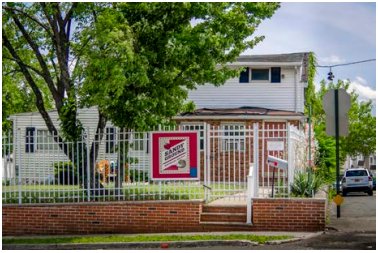
The community of Sandy Ground in southwestern Staten Island’s present-day Rossville neighborhood is the oldest community established by free Black people in North America, and
the oldest continuously settled free Black community in the United States. Known at other times as Harrisville and Little Africa, a 1963 fire destroyed much of the community, but the Sandy Ground Historical Society, museum, and library works to preserve materials related to the history of the community. The museum holds the largest collection of African American culture and history on Staten Island, provides educational tours and workshops, and raises money for archaeological work in the area.
Free Black people from Maryland’s eastern shore established the settlement of Sandy Ground—named for its poor-quality soil—in the mid-1820s. Fleeing laws that restricted the rights of free Black people in Maryland, around twenty families trekked to Staten Island. In February of 1828, Captain John Jackson was the first Black man to purchase land in Richmond County (now Staten Island.) The original community around the intersection of Bloomingdale and Woodrow Roads grew as freed and escaped enslaved people from Virginia and Delaware and Black families from New York, New Jersey, and Connecticut arrived. Many of these original settlers were skilled in oyster harvesting, a major component of Staten Island’s economy during the nineteenth century. Prince’s Bay, a prime site of oyster harvesting, was within walking distance of Sandy Ground. Other residents of Sandy Ground grew fruits and vegetables; still others were skilled blacksmiths.
Residents of Sandy Ground established the Zion African Methodist Episcopal Church (now the Rossville AME Zion Church) in 1850. One of four Black congregations on the island founded before 1900, nearby Rossville AME Zion Church still houses an active congregation. The church became an important meeting point for the community as the area became a significant stop on the Underground Railroad. Captain Jackson may also have used the ferry boat he owned to ferry people escaping slavery across the Kill van Kull from New Jersey to Staten Island. In addition to Sandy Ground, the Livingston area on Staten Island may have also housed stops on the Underground Railroad, as a group of prominent abolitionists lived there.
About 150 African Americans lived in Sandy Ground by 1880, and by 1900 it had about 200 residents from 50 families. But when the city banned oystering in the polluted harbor in 1916, an economic decline began in the community as many left the area, although some families did remain, finding other work. But a 1963 fire destroyed much of what remained of the old Sandy Ground community, and many of the remaining families who could not afford to rebuild moved away. At the same time, developers began to buy up large lots of land in the area.
Ten families descended from Sandy Ground’s original settlers still live in the community. While Sandy Ground was designated a state and historical landmark in 1974 and 1982, the community still contends with the infringement of development as the Sandy Ground Historical Society in particular works to uncover and preserve the community’s rich history.
